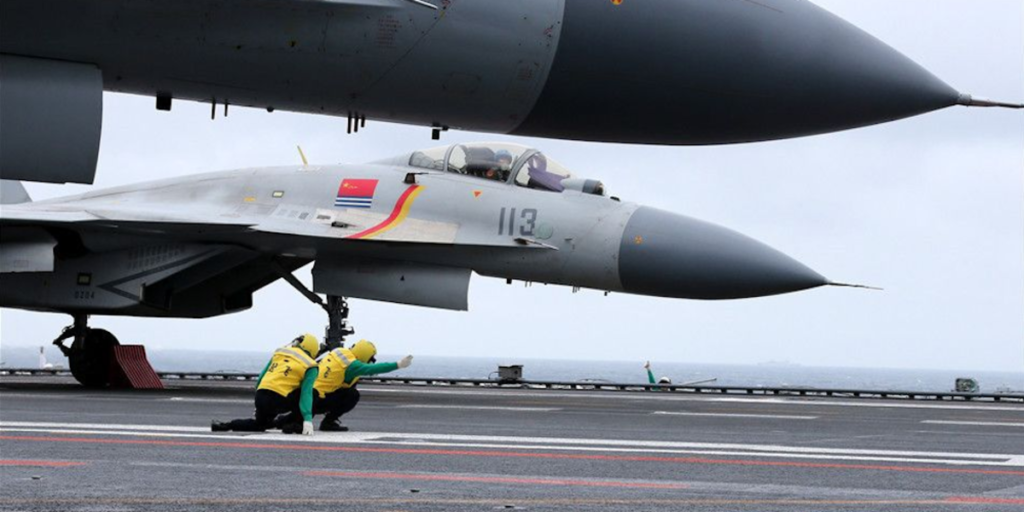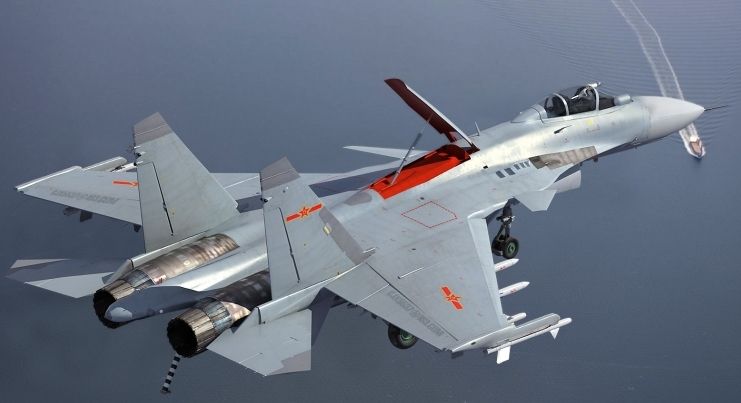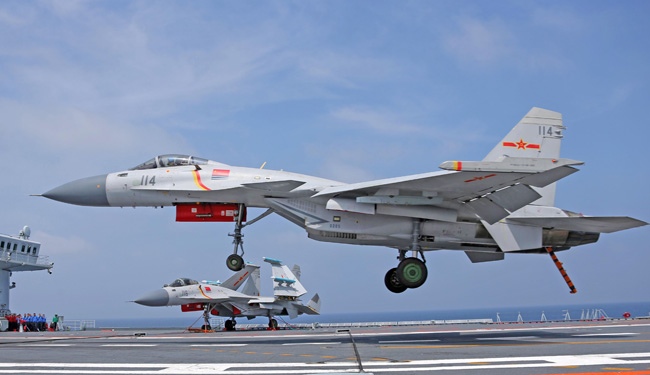The Chinese J-15 fighter jet, also known as Flying Shark, is classified as a fourth generation carrier-based fighter.
Introduce
China has just commissioned its newest aircraft carrier into the South Sea Fleet, the Shandong, with the hull number 17. It is also the first Chinese-made aircraft carrier. The Shandong aircraft carrier can carry up to 40 aircraft of all types, of which the only fighter that can operate on Chinese carrier is J-15 fighter jets.
Beijing plans to build at least four aircraft carrier combat groups by 2030, with the ambition of developing a naval force that can operate globally. To meet this goal, China needs at least 130 carrier-based fighters by 2030. At present, J-15 is the only Chinese carrier-based fighter with an estimated 30 aircraft.
Background
In the 1990s, China arranged to be allowed to build a licensed copy of the Su-27, called Shenyang J-11. Beijing later stopped, but they silently developed their own domestic version based on what they had, creating Shenyang J-11B, they also created a indigenous turbofan engine, the WS-10. Soon the Russians found out, and they were dissatisfied with the way China worked.
At that time, the Chinese Army planned to acquire the rusty aircraft carrier Varyag from Ukraine, previously built by the Soviet Union, paving the way to build a mighty navy force. But aircraft carriers will be nothing without jets that can operate with it. For years, Beijing has been doing its best to buy Su-33, an carrier-based version of the Su-27, from Russia. Learning from the Flanker deal, the Russians refused.
Undeterred, China decided to develop its own carrier-based fighter. Luck came to China when they approached an unfinished Su-33 prototype acquired from Ukraine in 2001, the T-10K-3 prototype. Chinese engineers studied the prototype, reversed the design, combined with the previous J-11B experience, and eventually the J-15 was born. J-15 program was officially started in 2006. On November 25, 2012, the aircraft successfully performed its first takeoff and landing on China’s first aircraft carrier Liaoning.

Design
The Chinese J-15 fighter jet, also known as Flying Shark, is classified as a fourth generation carrier-based fighter. Like the Su-33, the J-15 is a heavy fighter with an empty weight of 17.5 tons and a maximum takeoff weight up to 33 tons.
Other basic parameters include a length of 21.9m, a wingspan of 14.7m, a width of 7.4m and a height of 5.92m.
The design of the J-15 completely inherits the characteristics of the Su-33, the pair of vertical tail fins, swept wings and forward canards. The most recognizable feature of the Sukhoi aircraft is the pair of large rectangular air intakes under the fuselage that also appear on the Chinese version.
The glass cockpit is located behind the slender nose, designed to provide excellent visibility for pilot on all sides. In addition, the J-15 has a modern ‘glass cockpit’ with hands-on-throttle-and stick controls transmitting commands through a fly-by-wire system, and a modern heads-up display.
Chinese J-15 also has an Infrared Search and Track System and laser-range finder turret in front of the canopy which is useful for discretely stalking adversaries at short range and detecting stealth aircraft. The airframe is also reportedly covered in radar-absorbent coating, though there’s little data on whether its radar cross section is much improved from the Flanker’s, and a Missile Approach Warning System absent from the Su-33. The undercarriage is still a familiar design with two single wheel main legs and a double wheel nose leg, all retractable to create a complete aerodynamic design.

Powerplant
Powering the J-15 is a pair of turbofan engines. Based on what it learned from the Russians, China developed a domestic engine, the WS-10. The original WS-10 engines proved unreliable under ocean conditions and the first J-15s were fitted with Russian-made AL-31Fs. This is also part of the reason China cannot mass produce J-15, due to its dependence on jet engine supply.
According to Chinese media, their engineers have overcome technical errors on WS-10H engines, which have achieved thrust and durability equivalent to Russia’s AL-31F engines. This allows China to mass produce J-15 in the near future. Theoretically, the J-15 can reach a maximum speed of Mach 2.46, the ferry range is 3,500 km, the service ceiling is 20,000m.
Armament
In terms of weapons, the J-15 is armed with a 30mm cannon and ten hardpoints which can carry long-range R-77 and PL-12 radar-guided missiles, as well as short-range High Off-Boresight PL-8 or 9 and R-73 heat-seeking missiles.
In addition to unguided bombs and rocket, a Flying Shark can carry a variety of Ying Ji anti-ship munitions, including the supersonic YJ-91, the subsonic YJ-83K, and anti-radar homing missiles to take out air defense radars. It also installed a locally manufactured Active Electronically-Scanned Array radar system.

Development potential
Chinese military scholars believe that, considering some features, J-15 shows superiority when placed next to the US F/A-18E/F Super Hornet. But the fact is that Chinese aircraft carriers all have ski-jump decks, while the J-15 and Su-33 are among the heaviest aircraft fighters available today. That will severely limit the amount of fuel and weapons it can carry, thereby limiting the range and effectiveness of combat. The J-15 also has an in-flight refueling probe which could help it overcome range limitations, but Chinese carriers do not yet have a carrier-based refueling plane and would depend on land-based tankers.
The J-15 project was time-consuming and more expensive than expected, and the aircraft delivered were also less reliable. Since being put into service in 2013, these fighters have been in constant accidents, causing great losses to the Chinese Naval Air Force. Serious accidents in 2016 caused the Chinese navy to worry so much that it banned the flight of all J-15 squadrons for three months, and called for an investigation. J-15 has exposed many problems, including flight control system instability is a major factor leading to the crashes. Experts also believe that Chinese designers have not fully grasped the inner idea of the T-10K prototype, they simply simulated it, resulting in poor performance of J-15.

Despite the difficulties, the J-15 is still playing an active role, creating the backbone of the Chinese Navy Air Force. The J-15 airframe has a lot of potential if deployed from a more suitable aircraft carrier. Future carriers, such as the Type 003, are currently under construction by China, with a much larger deck than Liaoning, which will be able to deploy multiple aircraft simultaneously. And most importantly, the CATOBAR system will allow the J-15 to take off with a full fuel tank and carry more missiles. This could make the J-15 the most heavily armed and most capable carrier-based fighter in the world. Other carrier-based fighters from other countries also have frequent crashes during their first years of operation.
Thank you for visiting Military-wiki.com. I’m Dung Tran, the person behind all this content. I know some websites are copying my articles. Stop this, or at least respect me by citing the source from Military-wiki.com. Thank you.






















